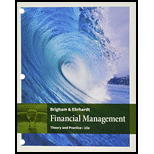
Bundle: Financial Management: Theory and Practice, Loose-leaf Version, 15th + Aplia, 1 term Printed Access Card
15th Edition
ISBN: 9781337130295
Author: Eugene F. Brigham, Michael C. Ehrhardt
Publisher: Cengage Learning
expand_more
expand_more
format_list_bulleted
Question
Chapter 16, Problem 8P
a)
Summary Introduction
To determine: Nominal annual cost of of its non-free trade credit.
b)
Summary Introduction
To determine: Whether it receives less or more credit than it might pad within fifteen days.
Expert Solution & Answer
Want to see the full answer?
Check out a sample textbook solution
Students have asked these similar questions
Jeff Krause purchased 1,000 shares of a speculative stock in January for $1.89 per share. Six months later, he sold them for $9.95 per share. He uses an online
broker that charges him $10.00 per trade. What was Jeff's annualized HPR on this investment?
Jeff's annualized HPR on this investment is %. (Round to the nearest whole percent.)
Congratulations! Your portfolio returned 16.7% last year, 2.5% better than the market return of 14.2%. Your portfolio had a standard deviation of earnings equal to
18%, and the risk-free rate is equal to 4.4%. Calculate Sharpe's measure for your portfolio. If the market's Sharpe's measure is 0.29, did you do better or worse than
the market from a risk/return perspective?
The Sharpe's measure of your portfolio is
(Round to two decimal places.)
On January 1, 2020, Simon Love's portfolio of 15 common stocks had a market value of $258,000. At the end of May 2020, Simon sold one of the stocks, which had
a beginning-of-year value of $26,900, for $31,400. He did not reinvest those or any other funds in the portfolio during the year. He received total dividends from stocks
in his portfolio of $11,900 during the year. On December 31, 2020, Simon's portfolio had a market value of $246,000. Find the HPR on Simon's portfolio during the
year ended December 31, 2020. (Measure the amount of withdrawn funds at their beginning-of-year value.)
Simon's portfolio HPR during the year ended December 31, 2020, is %. (Round to two decimal places.)
Chapter 16 Solutions
Bundle: Financial Management: Theory and Practice, Loose-leaf Version, 15th + Aplia, 1 term Printed Access Card
Ch. 16 - Define each of the following terms:
Working...Ch. 16 - What are the two principal reasons for holding...Ch. 16 - Prob. 3QCh. 16 - Prob. 4QCh. 16 - Prob. 5QCh. 16 - Prob. 6QCh. 16 - Prob. 7QCh. 16 - Prob. 8QCh. 16 - What kinds of firms use commercial paper?
Ch. 16 - Prob. 1P
Ch. 16 - Medwig Corporation has a DSO of 17 days. The...Ch. 16 - What are the nominal and effective costs of trade...Ch. 16 - Prob. 4PCh. 16 - Prob. 5PCh. 16 - Snider Industries sells on terms of 2/10, net 45....Ch. 16 - Prob. 7PCh. 16 - Prob. 8PCh. 16 - Grunewald Industries sells on terms of 2/10, net...Ch. 16 - The D.J. Masson Corporation needs to raise...Ch. 16 - Negus Enterprises has an inventory conversion...Ch. 16 - Prob. 12PCh. 16 - Dorothy Koehl recently leased space in the...Ch. 16 - Prob. 15PCh. 16 - Prob. 16PCh. 16 - The Raattama Corporation had sales of 3.5 million...Ch. 16 - Prob. 1MCCh. 16 - Prob. 2MCCh. 16 - Prob. 3MCCh. 16 - Is there any reason to think that RR may be...Ch. 16 - Prob. 5MCCh. 16 - Johnson knows that RR sells on the same credit...Ch. 16 - Prob. 7MCCh. 16 - Prob. 8MCCh. 16 - What is the impact of higher levels of accruals,...Ch. 16 - Assume that RR purchases $200,000 (net of...Ch. 16 - Prob. 11MCCh. 16 - Prob. 12MCCh. 16 - Prob. 13MCCh. 16 - Prob. 14MCCh. 16 - Prob. 15MCCh. 16 - In an attempt to better understand RR’s cash...
Knowledge Booster
Learn more about
Need a deep-dive on the concept behind this application? Look no further. Learn more about this topic, finance and related others by exploring similar questions and additional content below.Similar questions
- Chee Chew's portfolio has a beta of 1.27 and earned a return of 13.6% during the year just ended. The risk-free rate is currently 4.6%. The return on the market portfolio during the year just ended was 10.5%. a. Calculate Jensen's measure (Jensen's alpha) for Chee's portfolio for the year just ended. b. Compare the performance of Chee's portfolio found in part a to that of Carri Uhl's portfolio, which has a Jensen's measure of -0.25. Which portfolio performed better? Explain. c. Use your findings in part a to discuss the performance of Chee's portfolio during the period just ended.arrow_forwardDuring the year just ended, Anna Schultz's portfolio, which has a beta of 0.91, earned a return of 8.1%. The risk-free rate is currently 4.1%, and the return on the market portfolio during the year just ended was 9.4%. a. Calculate Treynor's measure for Anna's portfolio for the year just ended. b. Compare the performance of Anna's portfolio found in part a to that of Stacey Quant's portfolio, which has a Treynor's measure of 1.39%. Which portfolio performed better? Explain. c. Calculate Treynor's measure for the market portfolio for the year just ended. d. Use your findings in parts a and c to discuss the performance of Anna's portfolio relative to the market during the year just ended.arrow_forwardNeed answer.arrow_forward
arrow_back_ios
SEE MORE QUESTIONS
arrow_forward_ios
Recommended textbooks for you
 Intermediate Financial Management (MindTap Course...FinanceISBN:9781337395083Author:Eugene F. Brigham, Phillip R. DavesPublisher:Cengage Learning
Intermediate Financial Management (MindTap Course...FinanceISBN:9781337395083Author:Eugene F. Brigham, Phillip R. DavesPublisher:Cengage Learning EBK CONTEMPORARY FINANCIAL MANAGEMENTFinanceISBN:9781337514835Author:MOYERPublisher:CENGAGE LEARNING - CONSIGNMENT
EBK CONTEMPORARY FINANCIAL MANAGEMENTFinanceISBN:9781337514835Author:MOYERPublisher:CENGAGE LEARNING - CONSIGNMENT


Intermediate Financial Management (MindTap Course...
Finance
ISBN:9781337395083
Author:Eugene F. Brigham, Phillip R. Daves
Publisher:Cengage Learning

EBK CONTEMPORARY FINANCIAL MANAGEMENT
Finance
ISBN:9781337514835
Author:MOYER
Publisher:CENGAGE LEARNING - CONSIGNMENT
Debits and credits explained; Author: The Finance Storyteller;https://www.youtube.com/watch?v=n-lCd3TZA8M;License: Standard Youtube License